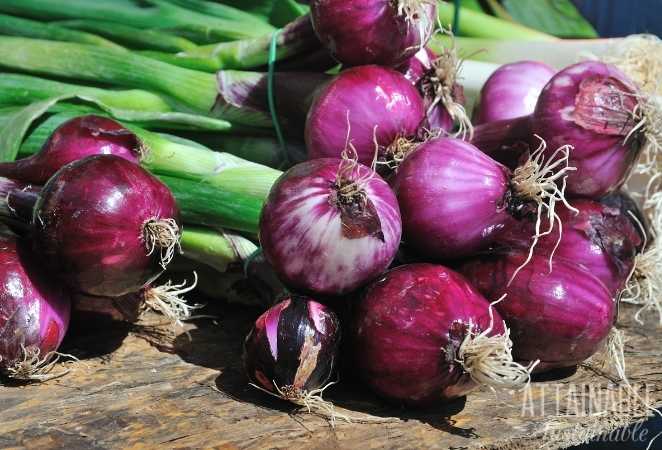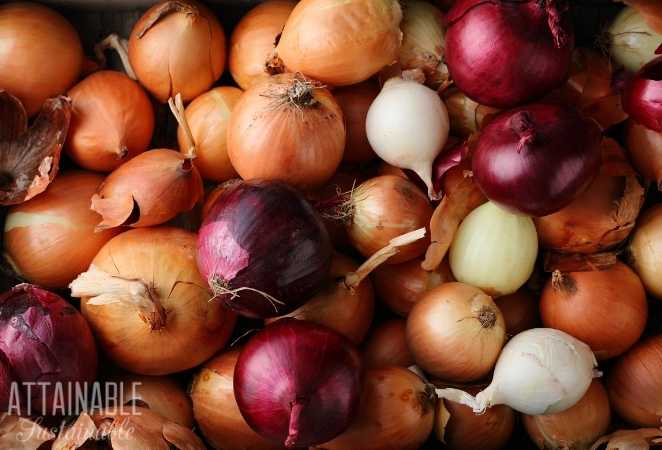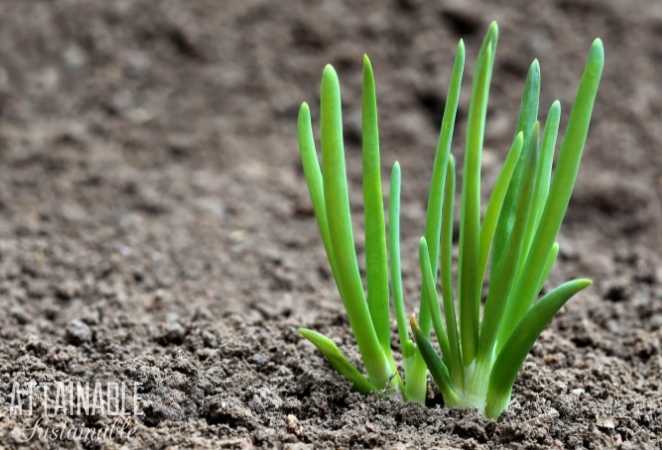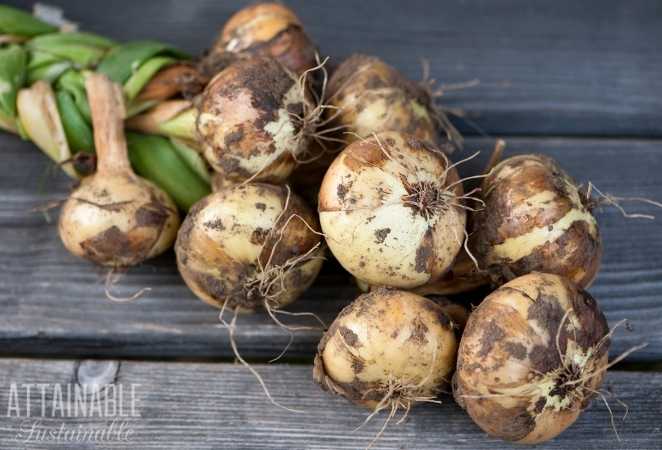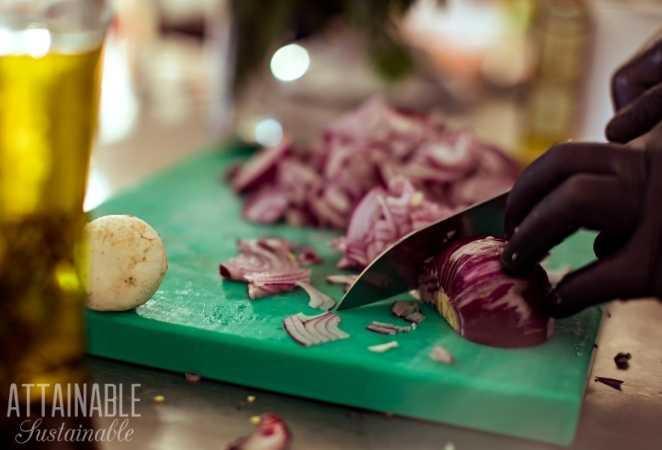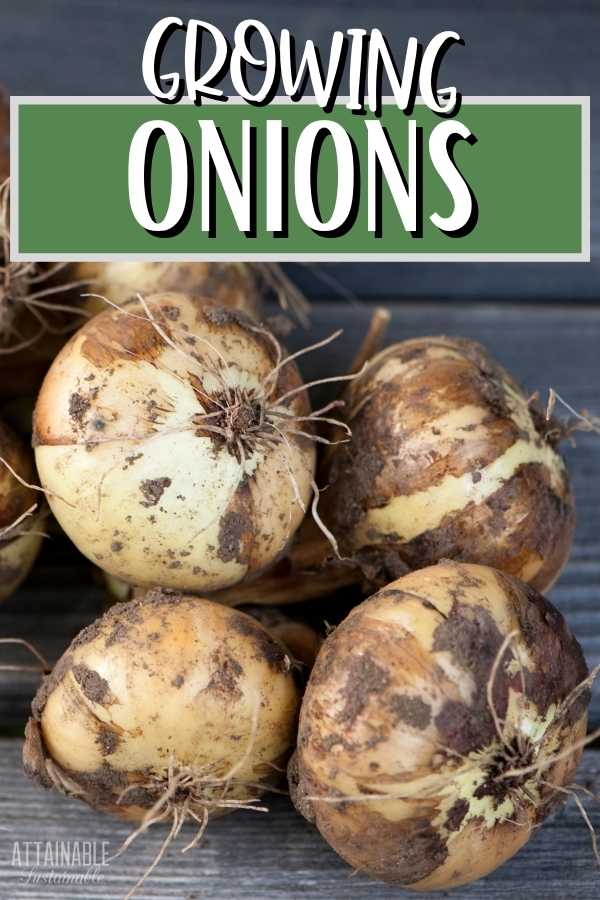People have been growing onions for at least 5000 years. One of the reasons for their popularity is the fact they keep for long periods of time without spoiling. Another is that onions are a key ingredient in just about any savory meal you can imagine.
If you are planting onions, you might want to try growing garlic, too!
Contributed by Jodi Torpey, author and Master Gardener.
New to gardening? Limited on space? The 5-Gallon Garden gives you the skills you need to grow food in the space you have. Get started with your garden today!
Introduction to onions (Allium cepa)
There are two important points to keep in mind when planting and growing onions. First, you need to select the type of onions that match the daylight hours in your region. Second, you need to give onions plenty of food so they can grow healthy leaves.
There are many kinds of onions to plant and grow, but no matter which onions you choose, be sure to select the kind that match your region’s day length.
Long-day varieties grow best in northern states where they need 14-16 hours of daylight to start the bulbing process.
Grow Some Greens!
Ready to grow fresh greens, no matter WHERE you live? Sign up for my
FREE quick-start guide and start growing some of your own food!
Short-day varieties do well in southern states because they bulb when day length is 10-12 hours.
Intermediate day varieties are also called day-neutral because they start bulbing when day length is 12-14 hours. These varieties can be grown just about anywhere.
Top considerations when choosing onions for gardens
When choosing onions, look for the day length and also days to maturity. The number of days is calculated from the date of transplanting into your garden. You can also choose onions based on shape, color and taste.
Vidalia onions are from Georgia and are known for being sweet and juicy. Maui onions come from their namesake Hawaiian island and they’re sweet and mild. Here’s a small sample of some popular onion varieties for you to plant and enjoy:
Long-day onion varieties
Yellow Sweet Spanish hybrid onions are extra-large and bright white with a sweet flavor; 110-120 days.
Walla Walla is a popular golden-skinned onion that is good-tasting but not long-lasting; 110-125 days
Intermediate-day onion varieties
Red Candy Apple is an adaptable red onion that tastes so sweet you can eat it like an apple; 85 days.
Red River hybrid onions are large, globe-shaped bulbs with deep red skin and excellent flavor. Can be stored 3-5 months; 105 days.
Short-day onion varieties
Yellow Granex hybrid is similar to sweet Vidalia onions with a yellow skin and tasty interior’ 100 days.
Texas Early Grano is a sweet white heirloom onion with a thin skin and mild flavor. These can grow to 1 pound each; 110 days.
How to plant onions using seeds, sets, or transplants
There are three ways you can plant onions in your garden: seeds, onion sets, or onion transplants.
If you want to start from onion seeds, depending on where you live either plant them indoors about 8-10 weeks before you want to transplant them in your garden or direct sow in your garden early in the season.
Many gardeners choose to plant onion sets or transplants because they’re more convenient and they speed up the growing process.
Onion sets are small bulbs that will grow into a larger bulb. Sets have already been through one bulbing process so sets grow onions faster than starting from seed.
Onion transplants are small onion plants that haven’t formed a bulb yet.
Onions are a cool weather crop and should be planted early to give them enough time to form good-sized bulbs. Plant onions when soil temperatures are around 60 degrees and as soon as the soil is dry enough to work in spring. The size of the finished onion bulb depends on the number of healthy green leaves the plant can grow. The more leaves mean bigger bulbs, so work to grow as many leaves as possible before the bulbs start forming.
Don’t wait too long to plant onions, because they don’t grow well once temperatures above 85 degrees.
Plant onion seeds about ¼-inch deep, onion sets about 1 inch deep and onion transplants about 1-3 inches deep or deep enough to keep plants upright. Space plants so their roots can spread, about 4-6 inches apart. Rows should be at least 15 inches apart.
You can plant them somewhat more closely and use the thinnings as green onions, too.
Requirements for growing onions
Light requirements
Prepare a spot that gets full sun, although onions can grow in partial shade, too.
Soil requirements
Before planting, amend garden beds and raised beds with compost or other organic matter and broadcast pre-plant fertilizer over the planting bed. Keep in mind onions may need twice the amount of fertilizer as other garden plants. Make sure to dig in deeply for a loose and well-draining soil to help roots get established quickly.
After plants start to grow, add an organic mulch to help the soil retain moisture and to avoid weeding around the delicate, shallow roots.
Water requirements
Drip irrigation or a soaker hose system will help keep soil consistently moist (not soggy) and keep leaves dry. It’s important to keep the leaves dry to prevent fungal problems.
Keep up good watering—about 1” worth per week especially in late summer—and fertilizing through the season. Sidedress plants about a month after planting by digging in fertilizer between the rows and away from the plants. Be sure to water after fertilizing.
Combatting pests and other problems
It’s important to protect onion plant leaves because healthy bulbs depend on healthy leaves. Watch for these issues:
Yellowing leaves signal onion plants may be getting too much water.
Onion flies are a problem because they lay eggs that grow into maggots. The maggots then tunnel into onion stems and bulbs. Protect plants from flies with floating row cover cloth tightly sealed at the edges.
Onion thrips are small insects that attack leaves. Because thrips are too small to see, watch for onion leaves that turn grey and curl. Try neem or insecticidal soap to get rid of them and next time, plant onion varieties that are thrips resistant.
Pink root is a soilborne fungal disease that harms bulbs. If pink root is common in your region, avoid planting onion sets that often carry the fungus.
How to grow onions in containers
You can grow onions in containers, as long as you have a large enough container to give onions the space they need to grow into bulbs. Select the correct day-length onions for your region and plant them early in the season.
Fill containers with a good-quality potting soil that includes a slow-release fertilizer. Plant onions according to instructions, spacing onions about 4-6 inches apart.
Keep soil evenly moist and don’t let plants dry out or bulbs may split. Keep up with fertilizing to keep growing leaves and healthy bulbs.
Harvesting onions for storing and cooking
When the onion tops start to fall over, stop watering. Without water, the onions bulbs will start to harden, which is important for long-term onion storage.
Carefully lift onions with a garden fork after the tops have fallen, but before the leaves have a chance to dry completely. Cure the onions in the garden by letting the leaves of one row cover the bulbs in another for between 7-14 days.
If the weather is rainy and wet, cure onions under cover. Make sure air is allowed to circulate around bulbs so they can dry completely.
After the tops are completely dry, cut them from the bulb, leaving about an inch above the bulb. Gently brush off any soil and store on a flat surface, spread apart in a cool dry place.
Using fresh onions
Cooks everywhere would be hard-pressed to name a savory recipe that didn’t include onions in some form. This caramelized onion jam is always a hit, as is this easy onion and mushroom tart. Dice them, fry them, grill them, add them to stews and soups, bake them, pickle them, freeze them, dry them or enjoy them by eating like a fresh apple.
Saving onion seeds
Because onions seed once every two years, you’ll need to schedule when to collect seeds. Be sure to save seeds from heirloom or open pollinated onion varieties and not any hybrids. Also, if you’ll be saving seeds from different varieties, plant them far apart—some seed savers say as much as 800 feet—to prevent crosspollination.
Watch for onion plants to bloom and wait for seed heads to dry. Collect the dried heads in a paper bag; shake to free the seeds. Let seeds dry before storing in an airtight container.

